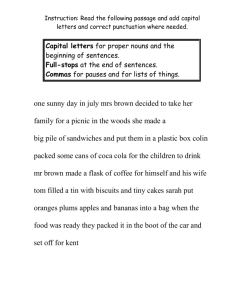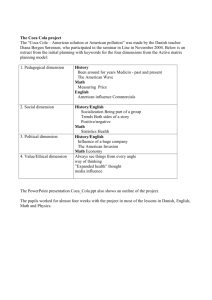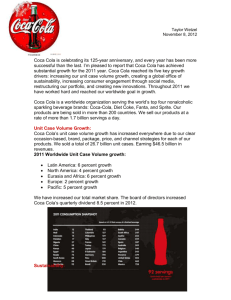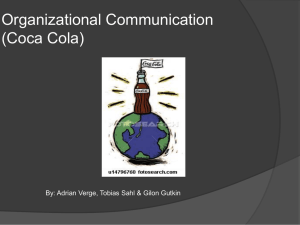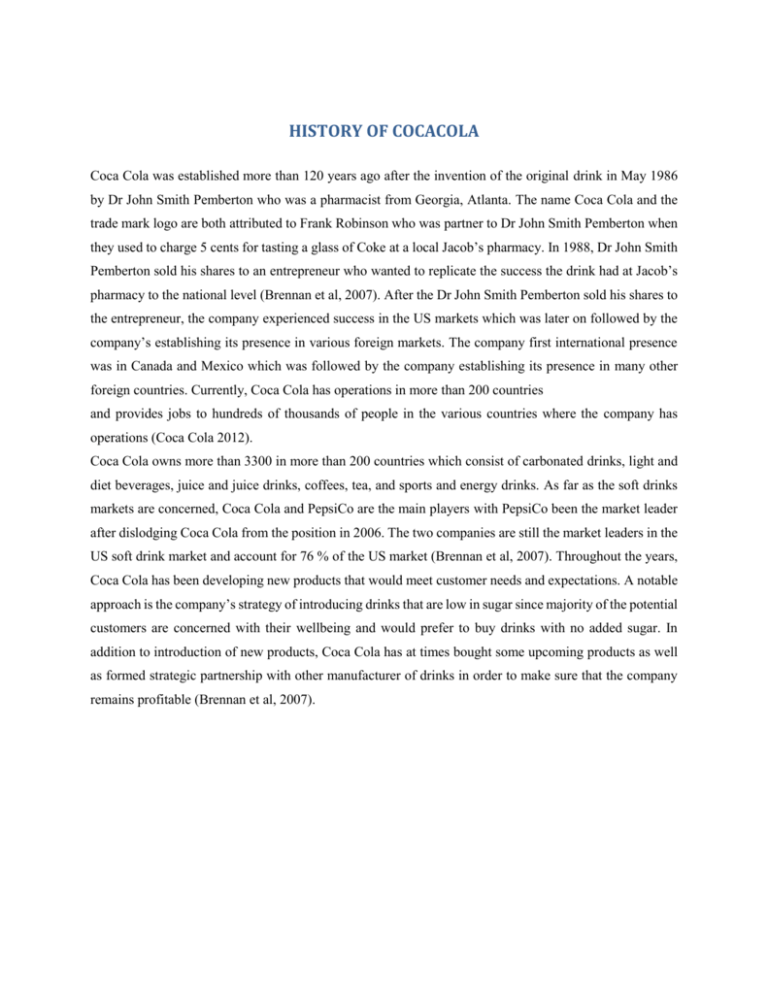
HISTORY OF COCACOLA
Coca Cola was established more than 120 years ago after the invention of the original drink in May 1986
by Dr John Smith Pemberton who was a pharmacist from Georgia, Atlanta. The name Coca Cola and the
trade mark logo are both attributed to Frank Robinson who was partner to Dr John Smith Pemberton when
they used to charge 5 cents for tasting a glass of Coke at a local Jacob’s pharmacy. In 1988, Dr John Smith
Pemberton sold his shares to an entrepreneur who wanted to replicate the success the drink had at Jacob’s
pharmacy to the national level (Brennan et al, 2007). After the Dr John Smith Pemberton sold his shares to
the entrepreneur, the company experienced success in the US markets which was later on followed by the
company’s establishing its presence in various foreign markets. The company first international presence
was in Canada and Mexico which was followed by the company establishing its presence in many other
foreign countries. Currently, Coca Cola has operations in more than 200 countries
and provides jobs to hundreds of thousands of people in the various countries where the company has
operations (Coca Cola 2012).
Coca Cola owns more than 3300 in more than 200 countries which consist of carbonated drinks, light and
diet beverages, juice and juice drinks, coffees, tea, and sports and energy drinks. As far as the soft drinks
markets are concerned, Coca Cola and PepsiCo are the main players with PepsiCo been the market leader
after dislodging Coca Cola from the position in 2006. The two companies are still the market leaders in the
US soft drink market and account for 76 % of the US market (Brennan et al, 2007). Throughout the years,
Coca Cola has been developing new products that would meet customer needs and expectations. A notable
approach is the company’s strategy of introducing drinks that are low in sugar since majority of the potential
customers are concerned with their wellbeing and would prefer to buy drinks with no added sugar. In
addition to introduction of new products, Coca Cola has at times bought some upcoming products as well
as formed strategic partnership with other manufacturer of drinks in order to make sure that the company
remains profitable (Brennan et al, 2007).
ANALYSIS
This includes the demographics, economics, ecological/environment, political, legal, informational, social,
and technological aspects that may have effect on operations of an organization. Conducting analysis is
important in any organization since it helps the organization understand the environment in which it is
conducting business in. (Kerin and Peterson, 2007). According to Brennan et al, (2007) analysis is the quite
effective since it reduces the risk of forgetting an important aspect of the environment within which a
company is operating in since it includes all the major aspects.
Demographic
Different ages have their specific requirements. The company targets the age group that consumes most of
its brand and customize promotional and marketing strategies that suit their behavior. The target market for
Coca Cola is based on age and most of its audience is the youth or the youngest. This is however, a wide
range of targeting with ages ranging from 15-25 but it extends to 40 years and more. The growing trend
among young adults is the need for healthier drinks with high juice content and low sugar content. (Brennan
et al, 2007)
In order to appeal to its target market, Coca Cola has increased its investment in promotional activities such
as family events, trade deals, bonus packs and in-store display. Coca Cola has been spending large part of
its promotional budget on sponsoring physical and nutritional education worldwide. Other promotional
activities conducted by the firm include development of physical-activity based clubs, health camps, and
funding to sports activities and clubs in many countries.
In order to serve the different segments, Coca Cola produces different brands for specific regions. Some of
the products developed for different markets include Qoo which is a light carbonated juice drink which is
targeted for Taiwan and Asian countries, Burn energy drink which is aimed at the Spanish and European
markets and Samuria in Afghanistan. (Coca Cola, 2012, Brennan et al, 2007)
Economic
Over the years, Coca Cola has been facing increased advertising controls, price restrictions, lack of
infrastructure, foreign exchange controls and increase competition from companies such as Cadbury
Schweppes and Pepsi (Brennan et al, 2007). These economical factors have in turn affected the market
share of Coca Cola in various countries.
Environmental
As discussed by Brennan et al, (2007), the impacts that Coca Cola operations have on environment can be
disastrous to the operation of the company. In India, Coca Cola together with its fierce rival Pepsi received
negative publicity after a report released by Indian based CSE showed that the two companies pumped a
lot of water from villages making public wells to dry up which resulted to people lacking access to enough
water that is necessary to meet their basic needs(Brennan et al, 2007). In response to these accusations,
Coca Cola was forced to minimize on its water usage by 25% and in addition build dams which would be
used to harvest rainwater.
Political
Being an international company Coca Cola faces different political landscapes in its areas of operation. The
company is faced with political instability in many countries where it has operations. Environment
protection laws imposed by governments in different countries have made the firm to undergo some hurdles
in their operations. In 2006, the company was sued by State of California for using lead in on its labels,
which it was forced to change. The company was also charged for practicing monopoly in Mexico after
forcing some restaurants and stores to agree to some exclusive contracts (Brennan et al, 2007).
Legal
Legal aspect includes the constraints or limits on business operations. In its bid to gain market monopoly
in Mexico, the company went against the Federal anti-competition laws prohibiting retailers to agree to
exclusive rights. Coca Cola faced the same regulation when it tried to acquire Cadbury Schweppes in 1999.
The company also faced EU regulations in 2005 after the company tried to force retailers to include its less
popular brands in addition to Coke (Brennan et al, 2007).
Informational
Coca Cola has a secret concentrate recipe that has enabled it to have control over its distribution channel.
This has enabled the company maintain strong control of the prices that bottlers pay for the concentrate,
their obligation to distribute and market Coca Cola products and regularly upgrade their plants. In addition,
Coca Cola also maintains the right to distribute its products directly to retailers and restaurants selling from
fountain pumps. The company’s franchisees are only allowed to distribute soft drinks products of producers
who are not in direct completion to Coca Cola. The company has also invested significantly in developing
bottlers and franchisees. Coca Cola has recently developed a multi-billion data warehousing and decision
support system in order to ensure efficient and effective communication with its affiliates around the globe
(Brennan et al, 2007). Since the company operates in different countries in different environments, Coca
Cola has been forced to restructure some of the practices so that they are in line with regulations in different
countries.
Social
There has been a rapid growth in the segment for healthier drinks with higher juice content and low sugar
content. The target markets for these drinks are adults above the age of 25 who are increasingly becoming
aware of health issues. The company introduced Coca Cola C2 in Japan, a product featuring low
carbohydrates, sugar, and calories. The company has produced more brands with low calories and sugar
such as Minute Made Light and Coke Zero (Brennan et al, 2007). Some brands are lifestyle oriented
targeting people with busy lifestyles, sports people, and mobile generation. Coca Cola has brands targeting
people according their lifestyles and this saw the introduction of energy drinks and drinks on plastic
packages.
Technology
Changes in technology have created opportunities for creation of new products and product improvements.
Another important factor is the emergence of new marketing technologies such as e-commerce and social
networking. The company has effective marketing, advertising, and promotional programs. The new
technology has made advertisement to make some products more attractive. The introduction of plastic
bottles and cans have significantly increased the sales of Coca Cola since they are easier to carry and
dispose. Technological advancement has enabled the firm to develop new environmentally friendly bottles
which are light weight (Kerin and Peterson, 2007).
USE OF FACEBOOK
Coca-Cola, which joined Facebook in 2008, has garnered over 60 million likes in just under five years by
focusing less on straightforward product promotion and more on its fans. Marketers have created a
community that is “a collection of your stories showing how people from around the world have helped
make Coke into what it is today.” As a result of this philosophy, Coca-Cola's success has been achieved
through statutes and photos that encourage engagement and interaction, supporting causes and integrating
other forms of social media.
At the starting date of this data collection, Coca Cola’s Facebook page held 79.872.404 fans ending up
with 80.210.339 fans after five days. Six years after its creation Coke’s page exhibits an average daily
growth of 84.484 fans and a weekly growth of 337,935 members.
On the other hand, customer engagement presents an average daily and a weekly growth of 47.474 and
189.898 fans respectively. This variable could be tested thanks to Facebook’s new insight metric “people
talking about this” which measures the amount of fans who link the page, post on coke’s wall, comment,
share Coca Cola content on their status and interact with the page (liking, tagging, using applications,
responding to an event or answering questions posted by the page). By the end of this research the amount
of people talking about Coca Cola had reached 461.845 in contrast to the 271.947 people observed at the
beginning of the week.
Data collection schedule:
Time as a fan: 20-Feb-2014 onwards
Total observation hours: 39 approximately.
How Coca-Cola reached over 80 million fans on Facebook
• Encouraging fan interaction – Posting content such as fill in the blank which takes users seconds to
respond to.
• Being on the cultural pulse – Posting to toast the success of Women’s US Boxer Marlen Esparza during
the 2012 Olympic Games.
• Asking questions – Posting questions that only require 1-2 word answers.
• Posting shareable content – Posting pictures of their macsot, the polar bear, which induces users to
comment with “awww” and to share the image
• Being funny
TOOLS USED ON FACEBOOK
News feed
Every time Coca Cola posts content on its wall news feeds in the fans’ Facebook Homepage, where their
network activity can be observed, are displayed. Coca Cola has no control over the presentation of this
information to their fan base as it relies on complex algorithms design by Facebook. Moreover Coca Cola
followers, as individual users of the SNS, have the option of highlighting or hiding Coca Cola’s posts.
Mini feed
The mini feed feature has been observed in the following sections of Coca Cola’s corporate page:
Friend activity tab: displays the actions conducted on Coca Cola’s page by fan's friends.
The information shown varies from likes to comments, status mentions, tags or checks in.
Wall tab: while navigating through the wall, fans can highlight, through mini feeds, Coca Cola’s recent
activity by using the filtering options available in the top right corner of the page. The page owner has the
ability of choosing which information is going to be presented using this feature. It was observed that
only Coca Cola’s posts, information updates and comments on fans’ pictures where displayed.
Wall
The wall feature is the landing tab when joining Coca Cola on Facebook. Fans are allowed to post and/or
upload multimedia content such as photos, links or videos.
Post can be filtered by brand posts, top posts or most recent. Coca Cola’s posts and fans’ posts which
include direct references to the brand can be re-shared, an additional feature complementing the
traditional options of liking and commenting.
It was observed that 78.6% of Coca Cola’s status updates incorporated multimedia content being in
54.5% of the cases a photo. Both English and Spanish posts were observed however it was the latter the
most common choice of language (71.4%) as most of the messages were targeted by fans’ location. Link
to external websites were included in the 14,3% of the posts.
Data related to fans’ response and the number of lines used by Coca Cola on each post is condensed in
table 5.2
Videos
Coca Cola corporate page presents a separated section were the brand and fan’s uploaded videos are
displayed. For each video uploaded by Coca Cola fans response with 5.4 video uploads. Duration and
fan’s response to Coca Cola videos is shown in table 5.5
Regarding the editing options available on Facebook, 80% of the videos uploaded had an English
description. Tagging was not allowed in any case. The brand logo appeared in 50% of the cases in
contrast to the brand’s name or core offer which were present in 100% and 80% of the videos uploaded
respectively. Additional information concerning the characteristics of Coca Cola’s videos is presented in
table 5.6
Applications
Coca Cola uses both game applications within its Facebook page and links to downloadable applications
(on specific sections for that purpose):
The never ending dance of happiness: game application which encourages player to connect with friends
and win different prizes like festival tickets, head phones or others by earning points during the game.
Involves and avatar creation and has six different game levels.
Calendar: downloadable calendar application for the computer sponsored by Coca Cola. It enables to post
and create Facebook events as well as synchronization with Google calendar.
125 años: downloadable e-book which exposes 125 reasons to believe in a better world.
Page tab feature
The page tab is a feature used by major brands present at Facebook. It allows the page owner to develop
and customize new sections on the brand’s Facebook page. Once developed, the new sections appear on
the left margin of the website as shown in figure 5.5.
USE OF TWITTER
On their main twitter account, @CocaCola, Coca-Cola has:
691,616 followers
Following 67,733 users
1,322,000 tweets per quarter
Coca-Cola’s twitter success has to do with the fact that
Engages users by posting questions that require short answers
Hosts contests that get the users involved in the brand. A good example was last year’s hearth
month contest. The diet coke twitter page hosted the contest which required twitter users to post
heart related pictures with #showyourheart.
REFERENCES
Brennan, R. Tunisini A., Harrison D., Baraldi E. (2007) Contemporary Strategic Marketing. (2nd
Ed). New York: Palgrave Macmillan Coca Cola (2012). Company’s official website. Retrieved February
20, 2014 from www.cocacola.com
India Resource Centre, (2011). Water levels continue dropping sharply: Coca Cola extracts
groundwater even as farmers and communities left without water. Retrieved February 20,
2014 from www.indiaresource.org/news/2011/1008.html
Kerin, R. Peterson, R.P. (2007). Strategic marketing problems: cases and comments. California:
Pearson/Prentice Hall.
Kotler P., Keller K. (2011). Marketing Management, (14th Ed.) London: Prentice Hall.
Kumar D. (2010). Enterprise growth strategy: Vision planning and execution. England, Surrey:
Gower Publishing Ltd.
Lester A. (2009). Growth Management: Two hats are better than one. Hampshire: Palgrave
Macmillan.


